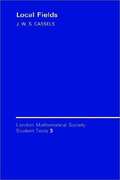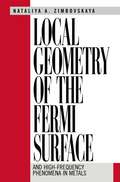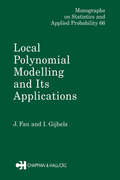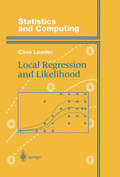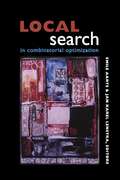- Table View
- List View
Local Density Theory of Polarizability (Physics of Solids and Liquids)
by Gerald D. Mahan K.R. SubbaswamyDuring the past decade the theoretical physics community has learned how to evaluate accurately polarizabilities and susceptibilities for many-electron systems such as atoms, solids, and liquids. The most accurate numerical technique employs a method often called the Time-Dependent Local Density Approximation, which is abbreviated TDLDA. The present volume is a review of recent research on the theory of po larizabilities and susceptibilities. Both authors have been doing these cal culations. However, this review surveys the entire field, summarizing the research of many contributors. The application of an external field, either ac or de, will induce a dipole moment which can be calculated and compared with experiment. For mod erately strong fields, both linear and nonlinear processes contribute to the moment. We cover topics such as polarizability, hyperpolarizability, pho toionization, phonons, and piezoelectricity. Density functional theory in the Local Density Approximation (LDA) has been shown to be a very accurate method for calculating ground state prop erties of electronic system. For static external fields, the induced moments are properties of the ground state. Then the calculation of the polarizability · is very accurate. For ac fields, the moment is not part of the ground state. However, the TDLDA methods are still very accurate.
Local Features in Natural Images via Singularity Theory (Lecture Notes in Mathematics #2165)
by James Damon Peter Giblin Gareth HaslingerThis monograph considers a basic problem in the computer analysis of natural images, which are images of scenes involving multiple objects that are obtained by a camera lens or a viewer’s eye. The goal is to detect geometric features of objects in the image and to separate regions of the objects with distinct visual properties. When the scene is illuminated by a single principal light source, we further include the visual clues resulting from the interaction of the geometric features of objects, the shade/shadow regions on the objects, and the “apparent contours”. We do so by a mathematical analysis using a repertoire of methods in singularity theory. This is applied for generic light directions of both the “stable configurations” for these interactions, whose features remain unchanged under small viewer movement, and the generic changes which occur under changes of view directions. These may then be used to differentiate between objects and determine their shapes and positions.
Local Fields (Graduate Texts in Mathematics #67)
by Jean-Pierre SerreThe goal of this book is to present local class field theory from the cohomo logical point of view, following the method inaugurated by Hochschild and developed by Artin-Tate. This theory is about extensions-primarily abelian-of "local" (i.e., complete for a discrete valuation) fields with finite residue field. For example, such fields are obtained by completing an algebraic number field; that is one of the aspects of "localisation". The chapters are grouped in "parts". There are three preliminary parts: the first two on the general theory of local fields, the third on group coho mology. Local class field theory, strictly speaking, does not appear until the fourth part. Here is a more precise outline of the contents of these four parts: The first contains basic definitions and results on discrete valuation rings, Dedekind domains (which are their "globalisation") and the completion process. The prerequisite for this part is a knowledge of elementary notions of algebra and topology, which may be found for instance in Bourbaki. The second part is concerned with ramification phenomena (different, discriminant, ramification groups, Artin representation). Just as in the first part, no assumptions are made here about the residue fields. It is in this setting that the "norm" map is studied; I have expressed the results in terms of "additive polynomials" and of "multiplicative polynomials", since using the language of algebraic geometry would have led me too far astray.
Local Fields (London Mathematical Society Student Texts #3)
by J. W. S. CasselsThe p-adic numbers, the earliest of local fields, were introduced by Hensel some 70 years ago as a natural tool in algebra number theory. Today the use of this and other local fields pervades much of mathematics, yet these simple and natural concepts, which often provide remarkably easy solutions to complex problems, are not as familiar as they should be. This book, based on postgraduate lectures at Cambridge, is meant to rectify this situation by providing a fairly elementary and self-contained introduction to local fields. After a general introduction, attention centres on the p-adic numbers and their use in number theory. There follow chapters on algebraic number theory, diophantine equations and on the analysis of a p-adic variable. This book will appeal to undergraduates, and even amateurs, interested in number theory, as well as to graduate students.
Local Geometry of the Fermi Surface: And High-Frequency Phenomena in Metals
by Natalya A. ZimbovskayaA treatment of the Fermi-liquid theory of high-frequency phenomena in metals, in paricular the effects due to local features in the geometry of the Fermi surface. The text develops a consistent theory of several effects, such as cyclotron resonances in magnetic fields normal to the surface. Topics covered include: basic equations of the Fermi-liquid theory; cyclotron Doppler on waves; local anomalies in the Fermi surface; cyclotron resonancce in metals; magneto-acoustic oscillations and the local geometry of the Fermi surface.
Local Homotopy Theory (Springer Monographs in Mathematics)
by John F. JardineThis monograph on the homotopy theory of topologized diagrams of spaces and spectra gives an expert account of a subject at the foundation of motivic homotopy theory and the theory of topological modular forms in stable homotopy theory.Beginning with an introduction to the homotopy theory of simplicial sets and topos theory, the book covers core topics such as the unstable homotopy theory of simplicial presheaves and sheaves, localized theories, cocycles, descent theory, non-abelian cohomology, stacks, and local stable homotopy theory. A detailed treatment of the formalism of the subject is interwoven with explanations of the motivation, development, and nuances of ideas and results. The coherence of the abstract theory is elucidated through the use of widely applicable tools, such as Barr's theorem on Boolean localization, model structures on the category of simplicial presheaves on a site, and cocycle categories. A wealth of concrete examples convey the vitality and importance of the subject in topology, number theory, algebraic geometry, and algebraic K-theory.Assuming basic knowledge of algebraic geometry and homotopy theory, Local Homotopy Theory will appeal to researchers and advanced graduate students seeking to understand and advance the applications of homotopy theory in multiple areas of mathematics and the mathematical sciences.
Local Jet Bundle Formulation of Bäckland Transformations: With Applications to Non-Linear Evolution Equations (Mathematical Physics Studies #1)
by F.A.E. Pirani D.C. Robinson W.F. ShadwickThe aim of this paper is to show that the theory of jet bundles supplies the appropriate setting for the study of Backlund trans formations. These transformations are used to solve certain partial differential equations, particularly non-linear evolution equations. Of course jets have been employed for some time in the theory of partial differential equations, but so far little use has been made of them in applications. In the meanwhile, substantial progress has been made in the study of non-linear evolution equations. This work has been encouraged by the dis covery of remarkable properties of some such equations, for example the existence of soliton solutions and of infinite se quences of conservation laws. Among the techniques devised to deal with these equations are the inverse scattering method and the Backlund transformation. In our opinion the jet bundle formulation offers a unifying geometrical framework for under standing the properties of non-linear evolution equations and the techniques used to deal with them, although we do not consider all of these properties and techniques here. The relevance of the theory of jet bundles lS that it legitimates the practice of regarding the partial derivatives of field variables as independent quantities. Since Backlund trans formations require from the outset manipulation of these partial derivatives, and repeated shifts of point of view about which variables are dependent on which, this geometrical setting clari fies and simplifies the concepts involved, and offers the prospect of bringing coherence to a variety of disparate results.
The Local Langlands Conjecture for GL (Grundlehren der mathematischen Wissenschaften #335)
by Colin J. Bushnell Guy HenniartThe Local Langlands Conjecture for GL(2) contributes an unprecedented text to the so-called Langlands theory. It is an ambitious research program of already 40 years and gives a complete and self-contained proof of the Langlands conjecture in the case n=2. It is aimed at graduate students and at researchers in related fields. It presupposes no special knowledge beyond the beginnings of the representation theory of finite groups and the structure theory of local fields.
Local Limit Theorems for Inhomogeneous Markov Chains (Lecture Notes in Mathematics #2331)
by Dmitry Dolgopyat Omri M. SarigThis book extends the local central limit theorem to Markov chains whose state spaces and transition probabilities are allowed to change in time. Such chains are used to model Markovian systems depending on external time-dependent parameters. The book develops a new general theory of local limit theorems for additive functionals of Markov chains, in the regimes of local, moderate, and large deviations, and provides nearly optimal conditions for the classical expansions, as well as asymptotic corrections when these conditions fail. Applications include local limit theorems for independent but not identically distributed random variables, Markov chains in random environments, and time-dependent perturbations of homogeneous Markov chains.The inclusion of appendices with background material, numerous examples, and an account of the historical background of the subject make this self-contained book accessible to graduate students. It will also be useful for researchers in probability and ergodic theory who are interested in asymptotic behaviors, Markov chains in random environments, random dynamical systems and non-stationary systems.
Local Lyapunov Exponents: Sublimiting Growth Rates of Linear Random Differential Equations (Lecture Notes in Mathematics #1963)
by Wolfgang SiegertEstablishing a new concept of local Lyapunov exponents the author brings together two separate theories, namely Lyapunov exponents and the theory of large deviations. Specifically, a linear differential system is considered which is controlled by a stochastic process that during a suitable noise-intensity-dependent time is trapped near one of its so-called metastable states. The local Lyapunov exponent is then introduced as the exponential growth rate of the linear system on this time scale. Unlike classical Lyapunov exponents, which involve a limit as time increases to infinity in a fixed system, here the system itself changes as the noise intensity converges, too.
Local Minimization, Variational Evolution and Γ-Convergence (Lecture Notes in Mathematics #2094)
by Andrea BraidesThis book addresses new questions related to the asymptotic description of converging energies from the standpoint of local minimization and variational evolution. It explores the links between Gamma-limits, quasistatic evolution, gradient flows and stable points, raising new questions and proposing new techniques. These include the definition of effective energies that maintain the pattern of local minima, the introduction of notions of convergence of energies compatible with stable points, the computation of homogenized motions at critical time-scales through the definition of minimizing movement along a sequence of energies, the use of scaled energies to study long-term behavior or backward motion for variational evolutions. The notions explored in the book are linked to existing findings for gradient flows, energetic solutions and local minimizers, for which some generalizations are also proposed.
Local Moduli and Singularities (Lecture Notes in Mathematics #1310)
by Olav Arnfinn Laudal Gerhard PfisterThis research monograph sets out to study the notion of a local moduli suite of algebraic objects like e.g. schemes, singularities or Lie algebras and provides a framework for this. The basic idea is to work with the action of the kernel of the Kodaira-Spencer map, on the base space of a versal family. The main results are the existence, in a general context, of a local moduli suite in the category of algebraic spaces, and the proof that, generically, this moduli suite is the quotient of a canonical filtration of the base space of the versal family by the action of the Kodaira-Spencer kernel. Applied to the special case of quasihomogenous hypersurfaces, these ideas provide the framework for the proof of the existence of a coarse moduli scheme for plane curve singularities with fixed semigroup and minimal Tjurina number . An example shows that for arbitrary the corresponding moduli space is not, in general, a scheme. The book addresses mathematicians working on problems of moduli, in algebraic or in complex analytic geometry. It assumes a working knowledge of deformation theory.
Local Multipliers of C*-Algebras (Springer Monographs in Mathematics)
by Pere Ara Martin MathieuMany problems in operator theory lead to the consideration ofoperator equa tions, either directly or via some reformulation. More often than not, how ever, the underlying space is too 'small' to contain solutions of these equa tions and thus it has to be 'enlarged' in some way. The Berberian-Quigley enlargement of a Banach space, which allows one to convert approximate into genuine eigenvectors, serves as a classical example. In the theory of operator algebras, a C*-algebra A that turns out to be small in this sense tradition ally is enlarged to its (universal) enveloping von Neumann algebra A". This works well since von Neumann algebras are in many respects richer and, from the Banach space point of view, A" is nothing other than the second dual space of A. Among the numerous fruitful applications of this principle is the well-known Kadison-Sakai theorem ensuring that every derivation 8 on a C*-algebra A becomes inner in A", though 8 may not be inner in A. The transition from A to A" however is not an algebraic one (and cannot be since it is well known that the property of being a von Neumann algebra cannot be described purely algebraically). Hence, ifthe C*-algebra A is small in an algebraic sense, say simple, it may be inappropriate to move on to A". In such a situation, A is typically enlarged by its multiplier algebra M(A).
Local Newforms for GSp (Lecture Notes in Mathematics #1918)
by Brooks Roberts Ralf SchmidtLocal Newforms for GSp(4) describes a theory of new- and oldforms for representations of GSp(4) over a non-archimedean local field. This theory considers vectors fixed by the paramodular groups and singles out certain vectors that encode canonical information, such as L-factors and epsilon-factors, through their Hecke and Atkin-Lehner eigenvalues. An appendix includes extensive tables about the results and the representations theory of GSp(4).
Local Pattern Detection: International Seminar Dagstuhl Castle, Germany, April 12-16, 2004, Revised Selected Papers (Lecture Notes in Computer Science #3539)
by Katharina Morik Jean-Francois Boulicaut Arno SiebesIntroduction The dramatic increase in available computer storage capacity over the last 10 years has led to the creation of very large databases of scienti?c and commercial information. The need to analyze these masses of data has led to the evolution of the new ?eld knowledge discovery in databases (KDD) at the intersection of machine learning, statistics and database technology. Being interdisciplinary by nature, the ?eld o?ers the opportunity to combine the expertise of di?erent ?elds intoacommonobjective.Moreover,withineach?elddiversemethodshave been developed and justi?ed with respect to di?erent quality criteria. We have toinvestigatehowthesemethods cancontributeto solvingthe problemofKDD. Traditionally, KDD was seeking to ?nd global models for the data that - plain most of the instances of the database and describe the general structure of the data. Examples are statistical time series models, cluster models, logic programs with high coverageor classi?cation models like decision trees or linear decision functions. In practice, though, the use of these models often is very l- ited, because global models tend to ?nd only the obvious patterns in the data, 1 which domain experts already are aware of . What is really of interest to the users are the local patterns that deviate from the already-known background knowledge. David Hand, who organized a workshop in 2002, proposed the new ?eld of local patterns.
Local Polynomial Modelling and Its Applications: Monographs on Statistics and Applied Probability 66 (ISSN)
by Jianqing FanData-analytic approaches to regression problems, arising from many scientific disciplines are described in this book. The aim of these nonparametric methods is to relax assumptions on the form of a regression function and to let data search for a suitable function that describes the data well. The use of these nonparametric functions with parametric techniques can yield very powerful data analysis tools. Local polynomial modeling and its applications provides an up-to-date picture on state-of-the-art nonparametric regression techniques. The emphasis of the book is on methodologies rather than on theory, with a particular focus on applications of nonparametric techniques to various statistical problems. High-dimensional data-analytic tools are presented, and the book includes a variety of examples. This will be a valuable reference for research and applied statisticians, and will serve as a textbook for graduate students and others interested in nonparametric regression.
Local Polynomial Modelling and Its Applications: Monographs on Statistics and Applied Probability 66 (ISSN)
by Jianqing FanData-analytic approaches to regression problems, arising from many scientific disciplines are described in this book. The aim of these nonparametric methods is to relax assumptions on the form of a regression function and to let data search for a suitable function that describes the data well. The use of these nonparametric functions with parametric techniques can yield very powerful data analysis tools. Local polynomial modeling and its applications provides an up-to-date picture on state-of-the-art nonparametric regression techniques. The emphasis of the book is on methodologies rather than on theory, with a particular focus on applications of nonparametric techniques to various statistical problems. High-dimensional data-analytic tools are presented, and the book includes a variety of examples. This will be a valuable reference for research and applied statisticians, and will serve as a textbook for graduate students and others interested in nonparametric regression.
Local Quantum Measurement and Relativity (Fundamental Theories of Physics #201)
by Christian BeckThis book treats various aspects of the quantum theory of measurement, partially in a relativistic framework. Measurement(-like) processes in quantum theory are identified and analysed; and the quantum operator formalism is derived in full generality without postulating operators as observables. Consistency conditions are derived, expressing the requirement of Lorentz-frame independence of outcomes of spacelike separated measurements and implying the impossibility of using quantum nonlocality to send signals faster than light. Local commutativity is scrutinized. The localization problem of relativistic quantum theory is studied, including comprehensive derivation of the theorems of Hegerfeld, Malament and Reeh-Schlieder. Finally, the quantum formalism is derived from the dynamics of particles with definite positions in Bohmian mechanics.
Local Quantum Physics: Fields, Particles, Algebras (Theoretical and Mathematical Physics)
by Rudolf HaagThe new edition provided the opportunity of adding a new chapter entitled "Principles and Lessons of Quantum Physics". It was a tempting challenge to try to sharpen the points at issue in the long lasting debate on the Copenhagen Spirit, to assess the significance of various arguments from our present vantage point, seventy years after the advent of quantum theory, where, after ali, some problems appear in a different light. It includes a section on the assumptions leading to the specific mathematical formalism of quantum theory and a section entitled "The evolutionary picture" describing my personal conclusions. Alto gether the discussion suggests that the conventional language is too narrow and that neither the mathematical nor the conceptual structure are built for eter nity. Future theories will demand radical changes though not in the direction of a return to determinism. Essential lessons taught by Bohr will persist. This chapter is essentially self-contained. Some new material has been added in the last chapter. It concerns the char acterization of specific theories within the general frame and recent progress in quantum field theory on curved space-time manifolds. A few pages on renor malization have been added in Chapter II and some effort has been invested in the search for mistakes and unclear passages in the first edition. The central objective of the book, expressed in the title "Local Quantum Physics", is the synthesis between special relativity and quantum theory to gether with a few other principles of general nature.
Local Regression and Likelihood (Statistics and Computing)
by Clive LoaderSeparation of signal from noise is the most fundamental problem in data analysis, arising in such fields as: signal processing, econometrics, actuarial science, and geostatistics. This book introduces the local regression method in univariate and multivariate settings, with extensions to local likelihood and density estimation. Practical information is also included on how to implement these methods in the programs S-PLUS and LOCFIT.
Local Search in Combinatorial Optimization
by Emile Aarts Jan Karel LenstraIn the past three decades, local search has grown from a simple heuristic idea into a mature field of research in combinatorial optimization that is attracting ever-increasing attention. Local search is still the method of choice for NP-hard problems as it provides a robust approach for obtaining high-quality solutions to problems of a realistic size in reasonable time. Local Search in Combinatorial Optimization covers local search and its variants from both a theoretical and practical point of view, each topic discussed by a leading authority. This book is an important reference and invaluable source of inspiration for students and researchers in discrete mathematics, computer science, operations research, industrial engineering, and management science. In addition to the editors, the contributors are Mihalis Yannakakis, Craig A. Tovey, Jan H. M. Korst, Peter J. M. van Laarhoven, Alain Hertz, Eric Taillard, Dominique de Werra, Heinz Mühlenbein, Carsten Peterson, Bo Söderberg, David S. Johnson, Lyle A. McGeoch, Michel Gendreau, Gilbert Laporte, Jean-Yves Potvin, Gerard A. P. Kindervater, Martin W. P. Savelsbergh, Edward J. Anderson, Celia A. Glass, Chris N. Potts, C. L. Liu, Peichen Pan, Iiro Honkala, and Patric R. J. Östergård.
Local Search in Combinatorial Optimization (PDF)
by Emile Aarts Jan Karel LenstraIn the past three decades, local search has grown from a simple heuristic idea into a mature field of research in combinatorial optimization that is attracting ever-increasing attention. Local search is still the method of choice for NP-hard problems as it provides a robust approach for obtaining high-quality solutions to problems of a realistic size in reasonable time. Local Search in Combinatorial Optimization covers local search and its variants from both a theoretical and practical point of view, each topic discussed by a leading authority. This book is an important reference and invaluable source of inspiration for students and researchers in discrete mathematics, computer science, operations research, industrial engineering, and management science. In addition to the editors, the contributors are Mihalis Yannakakis, Craig A. Tovey, Jan H. M. Korst, Peter J. M. van Laarhoven, Alain Hertz, Eric Taillard, Dominique de Werra, Heinz Mühlenbein, Carsten Peterson, Bo Söderberg, David S. Johnson, Lyle A. McGeoch, Michel Gendreau, Gilbert Laporte, Jean-Yves Potvin, Gerard A. P. Kindervater, Martin W. P. Savelsbergh, Edward J. Anderson, Celia A. Glass, Chris N. Potts, C. L. Liu, Peichen Pan, Iiro Honkala, and Patric R. J. Östergård.
Local Stability and Ultimate Boundedness in the Control of Robot Manipulators (Lecture Notes in Electrical Engineering #798)
by Marco A. Arteaga Alejandro Gutiérrez-Giles Javier Pliego-JiménezThis book offers a unique compendium of the authors´ own research on the use of theoretical stability analysis, showing how to take advantage of local stability design and ultimate boundedness for practical robot control. It addresses researchers and postgraduate students dealing with control theory, particularly with nonlinear systems. Thanks to the numerous worked examples, it could also be used as a textbook in postgraduate courses.



